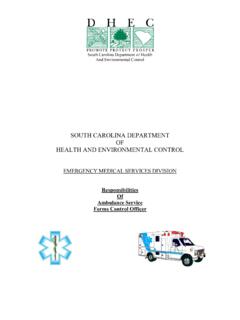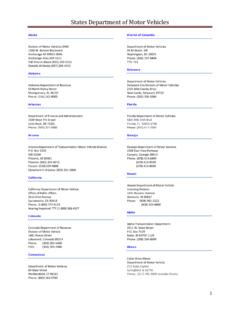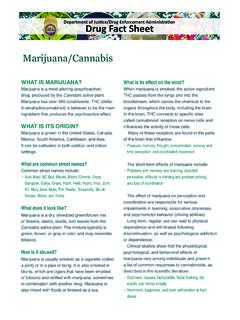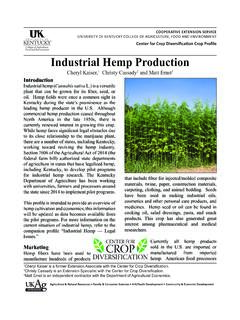Transcription of Drugs and Human Performance Fact Sheets
1 NATIONAL HIGHWAY TRAFFIC SAFETY ADMINISTRATION Drugs and Human Performance fact Sheets Technical Report Documentation Page 1. Report No. DOT HS 809 725 2. Government Accession No. 3. Recipient's Catalog No. 4. Title and Subtitle Drugs and H uman Performance fact Sheets 5. Report Date April 2014 (Revised) 6. Performing Organization Code 7. Author(s) COUPER, Fiona J. and LOGAN, Barry K 8. Performing Organization Report No. 9. Performing Organization Name and Address Washington State PatrolForensic Laboratory Services Bureau 2203 Airport Way S.
2 , Seattle, WA 98134 10. Work Unit No. (TRAIS) 11. Contract or Grant No. 12. Sponsoring Agency Name and Address National Highway Traffic Safety Administration 400 Seventh St., SW. Washington, DC 20590 13. Type of Report and Period Covered Final Report; August 2000-March 2004 14. Sponsoring Agency Code 15. Supplementary Notes The following toxicologists made significant contributions to both the drafting and review of the fact Sheets : Michael Corbett , Laurel Farrell MS., Marilyn Huestis , Wayne Jeffrey MS, and Jan Raemakers, James served as the NHTSA Contracting Officer's Technical Representative.
3 16. Abstract A panel of international experts on drug -impaired driving met in Seattle during August 2000 to review developments in the field of Drugs and Human Performance over the last 10 years; to identify the specific effects that both illicit and prescription Drugs have on driving; and to develop guidance for others when dealing with drug -impaired driving problems. Delegates represented the fields of psychopharmacology, behavioral psychology, drug chemistry, forensic toxicology, medicine, and law enforcement experts trained in the recognition of drug effects on drivers in the field.
4 These fact Sheets represent the conclusions of the Panel and include the state of current scientific knowledge in the area of Drugs and Human Performance for the 16 Drugs selected for evaluation. The selected Drugs include over-the-counter medications such as dextromethorphan and diphenhydramine; prescription medications such as carisoprodol, diazepam and zolpidem; and abused and/or illegal Drugs such as cocaine, GHB, ketamine, LSD, marijuana , methadone, methamphetamine, MDMA, morphine, PCP and toluene. Keyword continuation: illicit and licit Drugs and traffic safety, Drugs and driving, drug -impaired driving.
5 17. Key Words Carisoprodol, cocaine, dextromethorphan, diazepam, diphenhydramine, GHB,ketamine, LSD, marijuana ,methadone, methamphetamine,MDMA, morphine, PCP, toluene, zolpidem, 18. Distribution Statement 19. Security Classif. (of this report) none 20. Security Classif. (of this page) none 21. No. of Pages 100 22. Price Form DOT F (8-72) Reproduction of completed page authorized Table of Contents Page 3 7 Carisoprodol (and Meprobamate).. 13 19 25 29 35 Gamma-Hydroxybutyrate (GHB, GBL, and 1,4-BD).
6 39 45 Lysergic acid diethylamide (LSD).. 51 55 Methamphetamine (and Amphetamine).. 61 Methylenedioxymethamphetamine (MDMA, Ecstasy).. 67 Morphine (and Heroin).. 73 Phencyclidine (PCP).. 79 85 Zolpidem (and Zaleplon, Zopiclone).. 91 Biographical Sketches of Lead Authors and Main 97 Introduction The use of psychoactive Drugs followed by driving has been an issue of continual concern to law enforcement officers, physicians, attorneys, forensic toxicologists and traffic safety professionals in the and throughout the world.
7 At issue are methods for identifying the impaired driver on the road, the assessment and documentation of the impairment they display, the availability of appropriate chemical tests, and the interpretation of the subsequent results. A panel of international experts on drug -related driving issues met to review developments in the field of Drugs and Human Performance over the last 10 years; to identify the specific effects that both illicit and prescription Drugs have on driving; and to develop guidance for others when dealing with drug -impaired driving problems.
8 This publication is based on the deliberations of the International Consultative Panel on Drugs and Driving Impairment held in Seattle, WA in August 2000. This meeting was sponsored by the National Safety Council, Committee on Alcohol and other Drugs ; the State of Washington Traffic Safety Commission; and the National Highway Traffic Safety Administration. Delegates represented the fields of psychopharmacology, behavioral psychology, drug chemistry, forensic toxicology, medicine, and law enforcement experts trained in the recognition of drug effects on drivers in the field.
9 The fact Sheets reflect the conclusions of the Panel and have been designed to provide practical guidance to toxicologists, pharmacologists, law enforcement officers, attorneys and the general public on issues related to drug impaired driving. Sixteen Drugs were selected for review and include over-the-counter medications, prescription Drugs , and illicit and/or abused Drugs . The selected Drugs are cannabis/ marijuana , carisoprodol, cocaine, dextromethorphan, diazepam, diphenhydramine, gamma-hydroxybutyrate, ketamine, lysergic acid diethylamide, methadone, methamphetamine/amphetamine, methylenedioxymethamphetmaine, morphine/heroin, phencyclidine, toluene, and zolpidem.
10 The fact Sheets are based on the state of current scientific knowledge and represent the conclusions of the panel. They have been designed to provide practical guidance to toxicologists, pharmacologists, law enforcement officers, attorneys and the general public to use in the evaluation of future cases. Each individual drug fact sheet covers information regarding drug chemistry, usage and dosage information, pharmacology, drug effects, effects on driving, drug evaluation and classification (DEC), and the panel s assessment of driving risks.
















